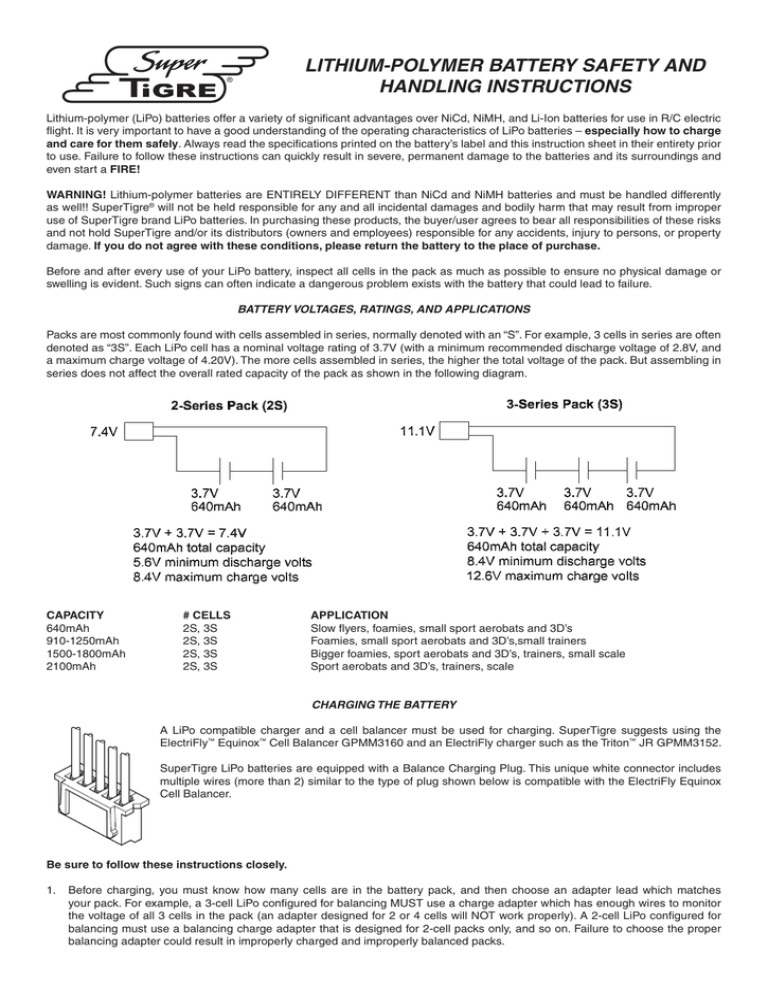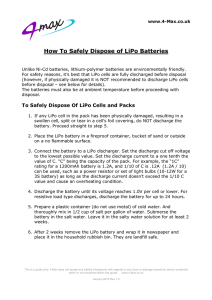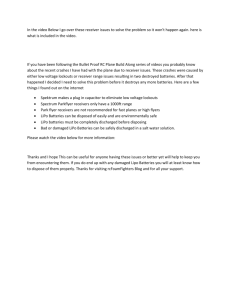LITHIum-POLYmER BATTERY SAfETY AND
advertisement

Lithium-Polymer Battery Safety and handling instructions ® Lithium-polymer (LiPo) batteries offer a variety of significant advantages over NiCd, NiMH, and Li-Ion batteries for use in R/C electric flight. It is very important to have a good understanding of the operating characteristics of LiPo batteries – especially how to charge and care for them safely. Always read the specifications printed on the battery’s label and this instruction sheet in their entirety prior to use. Failure to follow these instructions can quickly result in severe, permanent damage to the batteries and its surroundings and even start a FIRE! WARNING! Lithium-polymer batteries are ENTIRELY DIFFERENT than NiCd and NiMH batteries and must be handled differently as well!! SuperTigre® will not be held responsible for any and all incidental damages and bodily harm that may result from improper use of SuperTigre brand LiPo batteries. In purchasing these products, the buyer/user agrees to bear all responsibilities of these risks and not hold SuperTigre and/or its distributors (owners and employees) responsible for any accidents, injury to persons, or property damage. If you do not agree with these conditions, please return the battery to the place of purchase. Before and after every use of your LiPo battery, inspect all cells in the pack as much as possible to ensure no physical damage or swelling is evident. Such signs can often indicate a dangerous problem exists with the battery that could lead to failure. BATTERY VOLTAGES, RATINGS, AND APPLICATIONS Packs are most commonly found with cells assembled in series, normally denoted with an “S”. For example, 3 cells in series are often denoted as “3S”. Each LiPo cell has a nominal voltage rating of 3.7V (with a minimum recommended discharge voltage of 2.8V, and a maximum charge voltage of 4.20V). The more cells assembled in series, the higher the total voltage of the pack. But assembling in series does not affect the overall rated capacity of the pack as shown in the following diagram. CAPACITY 640mAh 910-1250mAh 1500-1800mAh 2100mAh # CELLS 2S, 3S 2S, 3S 2S, 3S 2S, 3S APPLICATION Slow flyers, foamies, small sport aerobats and 3D’s Foamies, small sport aerobats and 3D’s,small trainers Bigger foamies, sport aerobats and 3D’s, trainers, small scale Sport aerobats and 3D’s, trainers, scale CHARGING THE BATTERY A LiPo compatible charger and a cell balancer must be used for charging. SuperTigre suggests using the ElectriFly™ Equinox™ Cell Balancer GPMM3160 and an ElectriFly charger such as the Triton™ JR GPMM3152. SuperTigre LiPo batteries are equipped with a Balance Charging Plug. This unique white connector includes multiple wires (more than 2) similar to the type of plug shown below is compatible with the ElectriFly Equinox Cell Balancer. Be sure to follow these instructions closely. 1.Before charging, you must know how many cells are in the battery pack, and then choose an adapter lead which matches your pack. For example, a 3-cell LiPo configured for balancing MUST use a charge adapter which has enough wires to monitor the voltage of all 3 cells in the pack (an adapter designed for 2 or 4 cells will NOT work properly). A 2-cell LiPo configured for balancing must use a balancing charge adapter that is designed for 2-cell packs only, and so on. Failure to choose the proper balancing adapter could result in improperly charged and improperly balanced packs. 2a.When using an Equinox or any other balancer, connect the balancer to the charger first. Then connect the battery to the balancer. Be careful to use the correct adapter. 2b.When using a charger designed for balance charging, connect the battery directly to the charger. Be careful to plug battery into the correct socket. See your chargers instructions for more information. 3.Set the charger’s output voltage to match the nominal rated voltage of the entire LiPo battery pack. NEVER set the charger to a voltage which is greater than the nominal voltage rating of the LiPo pack or allow LiPo cells to charge to greater than 4.20V per cell at any time!! Overcharging LiPo cells will result in a permanent, catastrophic failure in the LiPo cells which will result in permanent damage to the battery and its surroundings, and cause personal injury! 4.Set the charger’s output current to NO GREATER than the “1C” rating of the battery. A battery’s “1C” rating equals the amount of current needed to fully charge the battery in one hour. For example, a battery with a capacity rating of 1200mAh has a 1C charge current rating of 1200mA (or 1.2 amps). A battery rated at 640mAh of capacity has a 1C rating of 640mA (or 0.6 amps). 5. Command the charger to start the charge process. WARNING: Be sure to READ AND FOLLOW all of the important “Safety and Handling Instructions” listed below regarding charging, discharging, storage, transporting, and handling of LiPo batteries. SAFETY AND HANDLING INSTRUCTIONS: Charging and Discharging • NEVER leave a LiPo battery unattended at any time while being charged or discharged!!! • ALWAYS monitor the battery and charger during the entire charging process! • NEVER attempt to charge a LiPo battery pack with a charger that is not capable of balance charging UNLESS you use a cell balancer similar to the ElectriFly Equinox (GPMM3160)! Failure to do so could result in damage to the battery and its surroundings, and result in personal injury. • NEVER apply a trickle charge to LiPo batteries. •A LWAYS charge and discharge LiPo batteries in a fireproof location, which could be a container made of metal (such as an ammunition box), ceramic tile, or a bucket of sand. • ALWAYS have a lithium approved “class D type” fire extinguisher available at all times. • NEVER charge or discharge a LiPo battery while it’s inside the model. A hot pack could ignite wood, foam, plastic, etc. •N EVER charge LiPo batteries at currents greater than the “1C” rating of the battery (“C” equals the rated capacity of the battery). •N EVER discharge LiPo batteries at currents which exceed the discharge current rating of the battery as this can often cause a cell to overheat. •N EVER allow LiPo cells to overheat at any time! Cells which exceed 140°F [60°C] during charge or discharge can and USUALLY WILL become damaged physically and possibly catch FIRE!! Always inspect a battery which has previously overheated and do not reuse it if you suspect it has been damaged in any way. •N EVER continue to charge LiPo batteries if the charger fails to recognize full charge. Overheating or swelling of the LiPo cells is an indication that a problem exists and the batteries should be disconnected from the charger immediately and placed in a fireproof location!! •A LWAYS discontinue charging or discharging a LiPo immediately if at any time you witness smoke or see the battery starting to swell up. This may cause the battery to rupture and/or leak, and the reaction with air may cause the chemicals to ignite, resulting in fire. Disconnect the battery and leave it in a safe fireproof location for approximately 30 minutes. • NEVER charge or discharge LiPo batteries with a NiCd or NiMH peak charger! •O NLY use a charger specifically designed for LiPo batteries which can apply the “constant current / constant voltage” charge technique (cc/cv). CONNECTING TO AN ESC •A LWAYS connect the battery’s lead marked “TO ESC” to the electronic speed control. NEVER attempt to connect the battery’s “CHARGE” lead to the ESC. • It is STRONGLY recommended to use an ESC which is designed to handle the low voltage cutoff points for LiPo batteries (always follow the instructions provided with the ESC for proper operation). Discharging LiPo batteries below 2.75V per cell can cause permanent damage and limit the number of times the battery can effectively be used again. 2 STORAGE AND TRANSPORTATION-BALANCING PLUGS • For long term storage it is recommended to charge the cells fully, then discharge them to 50-60% of their capacity. • Store battery at room temperature in cool or shaded area, ideally between 40-80°F. Temperatures exceeding 170°F for greater than 1 hour may cause damage to battery and cause a fire. • Do not expose battery packs to direct sunlight for extended periods of time, or place in direct contact with any liquids. If batteries come in contact with water, immediately dry the battery with a clean towel. • When transporting LiPo batteries, ALWAYS store them in a fireproof container. • NEVER leave batteries lying loosely anywhere in the car (in the trunk, backseat, floor, etc.). • NEVER leave LiPo batteries in the car indefinitely as temperatures inside the vehicle can easily rise far in excess of 120°F which could damage the battery. • ALWAYS make sure all plugs / connectors on the LiPo battery are covered, to prevent an accidental short. Small sections of fuel tubing make good insulators. • ALWAYS store LiPo cells/packs in a fireproof container and place in a secure location away from children. HANDLING AND FIRST AID INSTRUCTIONS • NEVER put loose cells or packs in the pocket of any clothing! • NEVER allow LiPo cells to come in contact with moisture or water at any time. • NEVER store batteries near an open flame or heater. • NEVER allow LiPo cells to become punctured, especially by metallic objects such as screwdrivers, T-pins, or hobby knives. •N EVER assemble LiPo cells or pre-assembled packs together with other LiPo cells/packs. Only a qualified battery assembly company should assemble or modify LiPo batteries. •D O NOT allow the battery’s internal electrolyte to get in the eyes or on skin. Wash affected areas with soap and water immediately if they come in contact with the electrolyte. If electrolyte makes contact with the eyes, flush with large amounts of water for 15 minutes and seek medical attention immediately! If a battery leaks electrolyte or gas vapors, do not inhale leaked material. Leave the area and allow the batteries to cool and the vapors to dissipate. Remove spilled liquid with absorbent and dispose. •A LWAYS provide adequate ventilation around LiPo batteries during charge, discharge, and during storage. If a battery becomes overheated IMMEDIATELY place it in a fireproof location until it cools. •A LWAYS make sure that metallic objects, such as wristwatches, bracelets, or rings are removed from your hands when handling LiPo packs. Accidentally touching battery terminals to any such objects could create a short circuit condition and possibly cause severe personal injury. BATTERIES INVOLVED IN A CRASH It is very important to remember that crash damage to LiPo batteries is much more dangerous than with NiCd or NiMH cells. It might appear that no physical damage occurred to a pack after a crash. However, LiPo batteries can often have a delayed chemical reaction, and while they may appear to be safe immediately after removing them from the crash, they can suddenly begin to smolder, emit smoke, and catch fire even after 30 minutes or an hour!! After a crash, remove the LiPo battery from the model but DO NOT immediately place it in a car or flight box and NEVER put it in your pocket. Instead, place the battery in a fireproof location and observe it for safety reasons. If possible, leave the battery in the safe location for 24 hours. CAUTION! Cells may be hot! Carefully inspect LiPo batteries which have been involved in a crash for even the smallest of cracks, splits, punctures or damage to the wiring and connectors. DISPOSAL OF LIPO BATTERIES Unlike NiCd batteries, LiPo batteries are environmentally friendly. For safety reasons, it’s best that LiPo cells be fully discharged before disposal (however if a pack or cell is physically damaged, it is NOT recommended to discharge LiPo cells before disposal – see below for details). The batteries must also be cool before proceeding with disposal instructions. To dispose of LiPo cells and packs: 1.If any LiPo cell in the pack has been physically damaged, resulting in a swollen cell or a split or tear in a cell’s foil covering, do NOT discharge the battery. Jump to step 5. 2. Place the LiPo battery in a fireproof container or bucket of sand. 3 3.Connect the battery to a LiPo discharger. Set the discharge cutoff voltage to the lowest possible value. Set the discharge current to a C/10 value, with “C” being the capacity rating of the pack. For example, the “1C” rating for a 1200mAh battery is 1.2A, and that battery’s C/10 current value is (1.2A / 10) 0.12A or 120mA. Or, a simple resistive type of discharge load can be used, such as a power resistor or set of light bulbs as long as the discharge current doesn’t exceed the C/10 value and cause an overheating condition. For LiPo packs rated at 7.4V and 11.1V, connect a 150 Ω resistor with a power rating of 2 watts (commonly found at Radio Shack) to the pack’s positive and negative terminals to safely discharge the battery. It’s also possible to discharge the battery by connecting it to an ESC/motor system and allowing the motor to run indefinitely until no power remains to further cause the system to function. 4.Discharge the battery until its voltage reaches 1.0V per cell or lower. For resistive load type discharges, discharge the battery for up to 24 hours. 5.Submerse the battery into bucket or tub of salt water. This container should have a lid, but it does not need to be airtight. Prepare a bucket or tub containing 3 to 5 gallons of old water, and mix in 1/2 cup of salt per gallon of water. Drop the battery into the salt water. Allow the battery to remain in the tub of salt water for at least 2 weeks. 6. Remove the LiPo battery from the salt water and place it in the normal trash. Power up with these other great SuperTigre products: SUPM1025 – SuperTigre 20 Amp ESC SUPM1035 – SuperTigre 30 Amp ESC SUPG8030 – SuperTigre 370 Brushless Motor SUPG8040 – SuperTigre 400 Brushless Motor SUPG8050 – SuperTigre .10 Brushless Motor SUPM0010 Adapter – SuperTigre LiPo to Deans Ultra Female Plug SUPM0020 Adapter – SuperTigre LiPo to Deans Micro Plug SUPM0030 Adapter – SuperTigre LiPo to Standard Male Plug SUPM0040 Adapter – Deans Ultra Male to SuperTigre ESC SUPM0060 Adapter – Standard Female to SuperTigre ESC SUPM0070 Charge Lead – Banana Plugs to SuperTigre LiPo For Technical Service and Support, please contact: Hobby Services 3002 N. Apollo Drive, Suite 1 Champaign, IL 61822 (217) 398-0007 hobbyservices@hobbico.com www.supertigre.com Contents © Copyright 2009 SUPZ1030


